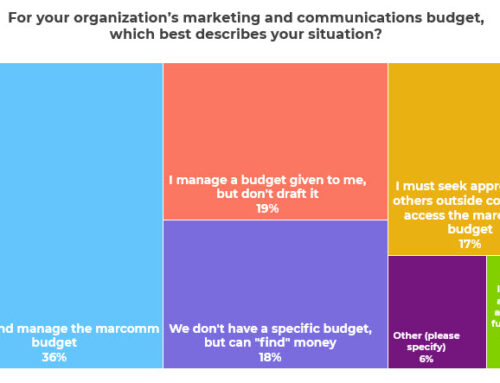
This Wednesday’s Webinar: Blogging for Nonprofits: October 29, 2008 |
Let’s assume for a minute that your nonprofit should write a blog in the first place (more on that question some other time). What kind of blog should you write?
You’ll find different categories of blogs, including a color-coded version and even a debate over whether we should categorize blogs at all.
I certainly think you can mix and match blog types, and I bet most successful blogs do. But I also think that it’s helpful to have one primary direction in mind and to categorize nonprofit blogs based on what your organization hopes to achieve by blogging and how you want your nonprofit to be perceived by your blog’s readers.
Your blog must be part of a larger communications strategy, and thinking of your blog in terms of your marketing goals will help ensure that integration. Take a look at these six goals and the kind of blog you would write as a result.
If you want to be known as a go-to source on a particular topic . . .
Write a news blog where you summarize and analyze the latest reports and commentary mostly from other sources, but also from your own organization. This kind of blog will include lots of links to other websites and blogs, with a great system of categories and tags to keep everything organized. These blogs are a mix of “reviewers” and “pointers.” This kind of blog is also a great way to combat your own information overload and to organize all the public stuff that your organization wants to keep track of. If you are big into social bookmarking (e.g. Delicious, Digg, StumbleUpon), this is your kind of blog.
If you want to be known as the “voice” on your issue . . .
Write an advocacy blog where you regularly explain situations that need changing and help us explore why your approaches are the best ways to bring about those changes. These nonprofit blogs help bring readers along by educating them on the issues, explaining the various options and positions out there (e.g. what works and what doesn’t) and helping us “see the light.” These blogs can range from policy wonk to zealous champion, but are very issue-oriented. They are mostly “producers” with some “reviewer” and “pointer” thrown in here and there.
If you want to be known as a resource, problem solver, or technical assistance provider . . .
Build a toolbox blog that’s heavy on how to’s, lists, case studies, interviews, and success stories. Show people how to solve their own problems, how to effect change for your cause, and where to go for more help and ideas. Give advice that empowers people to help you change the world.
If you want donors to better understand the need for and impact of your organization . . .
Create a storytelling blog where you share lots of anecdotes about the people you are helping, the partners you work with, the volunteers and donors who help you, and the staff and board who keep everything moving forward. I also sometimes call this the “insider” blog because much of the storytelling is about what happens behind the scenes, including the little victories and struggles along the way that may not be press release worthy, but still shed light on the realities of your work. Through stories, you are really letting donors see the world through your eyes and giving them an insider’s perspective.
If you want to build confidence in and support for your organization’s decisionmaking, leadership, and approaches . . .
Write a CEO/Executive Director blog, where the top executive for the organization writes about the nonprofit’s work, with a personal flair, in his or her own voice. This can be equally effective for large institutions that need to put a human face back on their work and for small or new organizations that need to build up trust and credibility with funders and partners. These blogs are also good venues for talking about the big picture and strategic decisionmaking. They don’t have to be written by the CEO per se, but are typically written by someone with significant authority within the organization.
If you want to capture your staff’s passion for their work without having an “official blog” . . .
Encourage staff to write professional life blogs. These blogs are technically personal blogs, but the content includes lots of information about the staff member’s work life and profession. They can be hosted on personal domains or on organizational domains, depending on the mix and just how much influence the organization will have over the content. These blogs are often focused on one particular niche within the larger field that a nonprofit works in. Sometimes they can go with the person when they leave the nonprofit and other times they stay with the position itself.
I can hear the screaming now . . . WHERE ARE THE EXAMPLES? I am leaving off examples on purpose for now, because I want to see if these categories ring true for you without placing specific visions in your mind. Do the nonprofit blogs you write and read fit these categories? Which nonprofit blogs fit into which categories? Which don’t? Please leave a comment and let me know what you think and what examples you’d suggest for the various categories. I’ll do a follow-up post where I refine these categories based on your comments and add links to example blogs I’m thinking of.
Learn more during this week’s webinar, Blogging for Nonprofits: Tips, Traps, and Tales on Wednesday.






